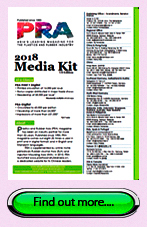PRA Chinese
Rubber Journal Asia Injection Moulding Asia Energy, Oil & Gas Asia
VISIT OUR OTHER SITES:
PRA Chinese
Rubber Journal Asia
Injection Moulding Asia
Energy, Oil & Gas Asia
Filter-feeding marine animals at risk from microplastics

Scientists are warning that microplastics in our oceans are posing a significant risk to filter-feeding marine animals like manta rays and whale sharks. Microplastics are small-sized plastic particles measuring under 5 mm.
A new analysis for the journal Trends in Ecology & Evolution, led by Murdoch University PhD student Elitza Germanov, warns that microplastics could be hazardous because they contain toxic chemicals.
Plastic-associated chemicals and pollutants can accumulate over decades and alter biological processes in the animals, leading to altered growth, development and reproduction, including reduced fertility, the analysis says.
While a definitive connection between microplastic ingestion and toxin exposure for filter feeders remains to be confirmed, studies into sea birds and small fish have found a link, Germanov says.
Marine filter feeders are likely to be at risk because they need to swallow hundreds to thousands of cubic metres of water daily in an effort to capture plankton. They can ingest microplastics directly from polluted water or indirectly through contaminated prey.
These species also tend to congregate in habitats which overlap with microplastic pollution hotspots, including the Gulf of Mexico, the Mediterranean Sea, the Bay of Bengal and the Coral Triangle, which is the marine area comprising the waters of South East Asian countries including Indonesia.
The article, Microplastics: No small problem for filter feeding megafauna, also says that indigestible plastic particles may damage the digestive systems of these iconic species
Germanov, who is also a researcher for the Marine Megafauna Foundation, said scientists are still trying to understand the magnitude of the microplastics problem.
“Despite the growing research on microplastics in the marine environment, there are only a few studies that examine the effects on large filter feeders,” she said.
“This is because it is difficult to assess plastic concentrations via conventional methods such as stomach analysis, because these are unsuitable for threatened species like whale sharks and manta rays.
“So we are using non-lethal sampling of small amounts of tissue, which we are testing for chemical tracers using sophisticated and sensitive analytical tools.
“I am working with Murdoch’s Separation Science and Metabolomics Laboratory to understand how levels of plastic associated toxins such as pesticides and industrial chemicals are building up in manta rays and whale sharks.”
Study co-author Professor Maria Cristina Fossi from the University of Siena in Italy, said her studies on whale sharks in the Gulf of California and on fin whales in the Mediterranean Sea confirmed exposure to toxic chemicals.
“As these areas are hotspots for microplastics, our results could indicate that filter feeders are taking up microplastics in their feeding grounds,” she said.
Germanov added that microplastic contamination had the potential to reduce population numbers of filter feeding animals, many of which are long-lived and have few offspring throughout their lives.
There are several species among the filter feeders that are listed by the IUCN (International Union for Conservation of Nature) as globally threatened species and are prioritised for conservation.
Germanov said understanding the effects of microplastic contamination through long-term metabolomics studies will help to shed light on the health of filter feeding species in response to plastic-associated toxins.
“As plastic production is projected to increase globally, the establishment of long-term monitoring programs is needed in the feeding grounds of these ocean giants, so we can check on toxicity levels in these creatures over a period of time,” she said.
“The microplastics issue potentially places the viability of nature based tourism involving these creatures under threat also. This kind of tourism is a significant source of income in the regions where filter feeders congregate.
“Raising awareness of this issue in communities, among governing bodies and industries could help to change behaviours around the production, management and use of plastics.” (source: murdoch.edu.au)
(PRA)Copyright (c) 2018 www.plasticsandrubberasia.com. All rights reserved.



























































